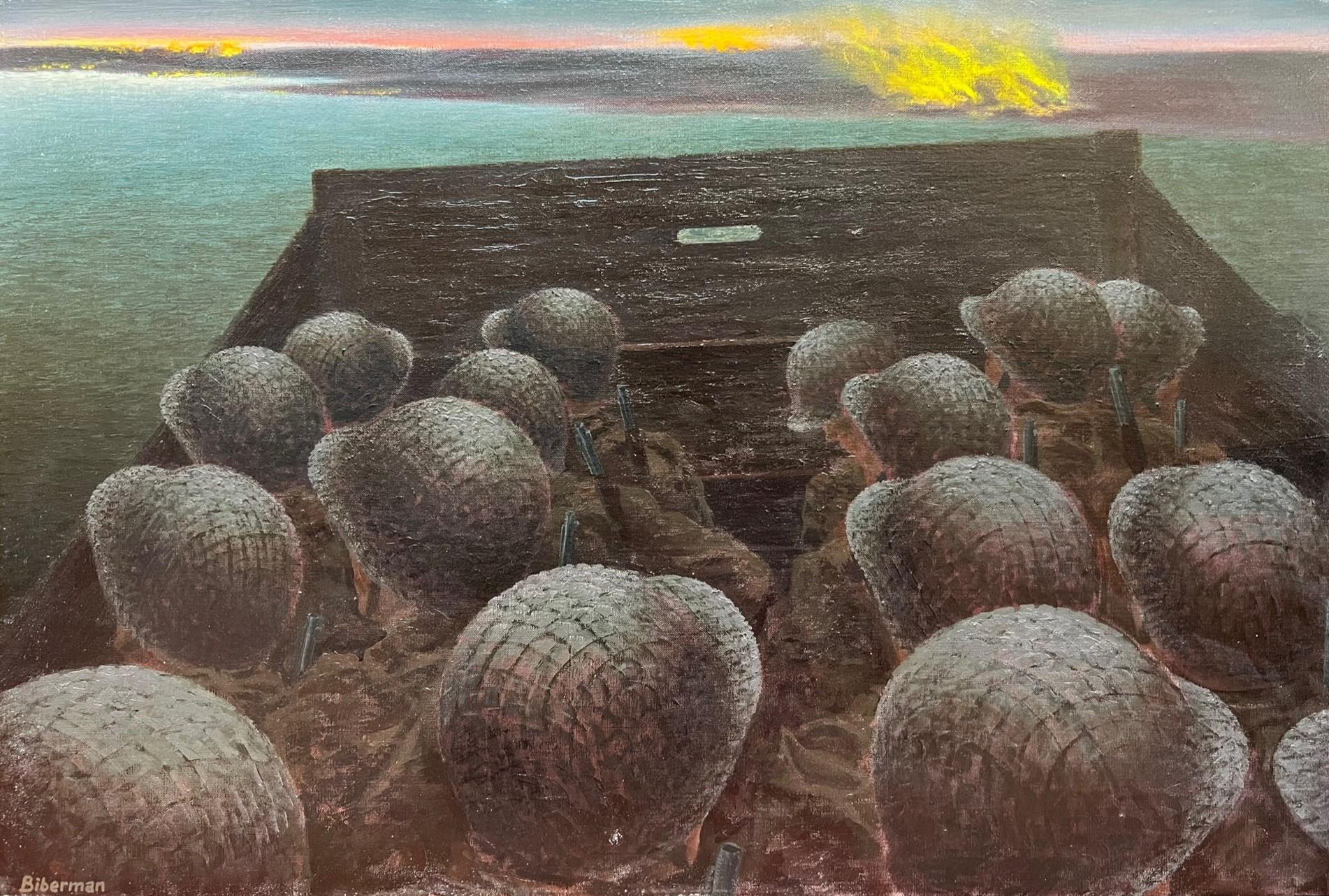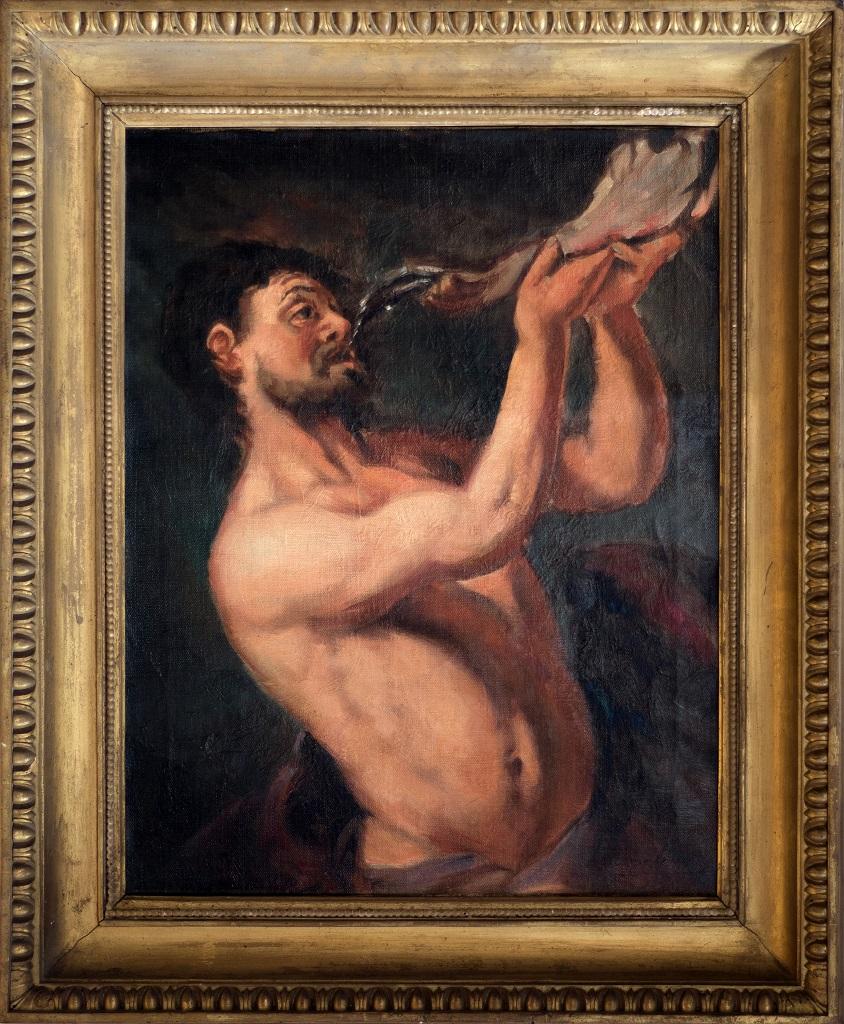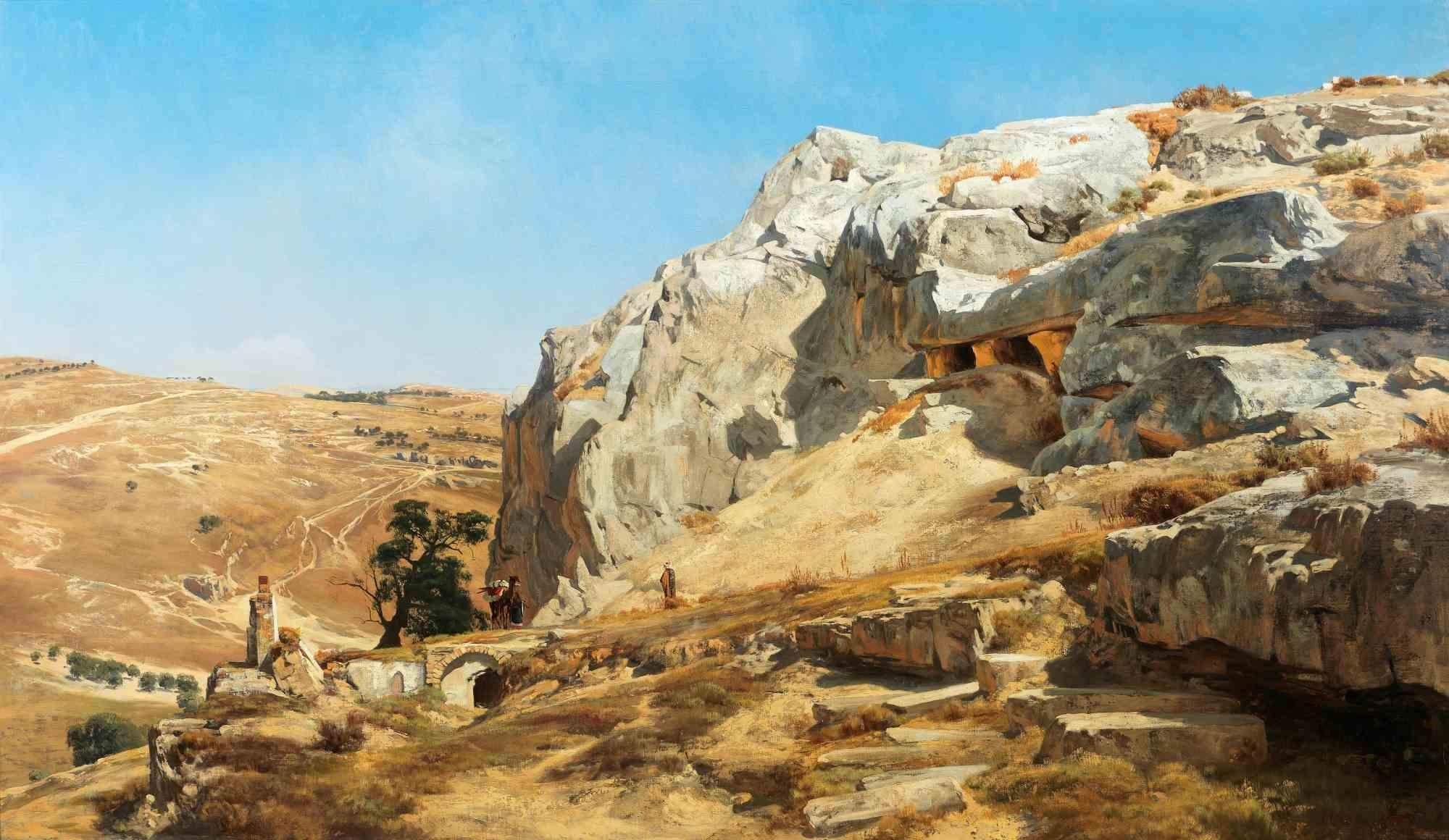Items Similar to Seated Man Portrait, Large Modernist Oil Painting WPA Artist
Want more images or videos?
Request additional images or videos from the seller
1 of 8
Nahum TschacbasovSeated Man Portrait, Large Modernist Oil Painting WPA Artist
About the Item
Nahum Tschacbasov was born in Baku, in the southeast of Russia. When he was eight years old, he came to America, where his family settled in Chicago.
His career, spanning more than five decades from the 1930’s to the 1980’s, is a kaleidoscope of influences, from modernism to the Byzantine style and expressionism of his Russian roots.
Tschacbasov’s paintings of the 1930’s reflect the social and political preoccupations of the times. He received considerable critical attention for his powerful dramatic satirical depiction of social injustice.
In the 1940’s he gained wider recognition when his style evolved into a fusion of Cubism and Surrealism. Through the influence of Jung, as well as currents brought to America by the newly arrived group of European Surrealists, he created a powerful personal iconography in which the inner workings of the psyche are revealed as myth and metaphor.
His first encounters with modern art are the works of Cezanne, Van Gogh, and Rouault. 1932-33 Tschacbasov moves for a short time to New York City in order to be in a modern art center and then to Paris, where he adopts the name Tschacbasov, an anagram of different family names. He studies with Leopold Gottlieb for eight months, then with Marcel Gromaire, who teaches him pictorial structure, and briefly with Fernand Leger. Working in his studio on the edge of Montmartre and later in the Hotel de Sante in Montparnasse, he produces a large body of work, retaining fifty paintings. After trips to North Africa, Spain, and the Balearic Islands, he travels often from Paris to New York City, where he spends six months painting a series of Depression-inspired pictures after finding that his American business has gone bankrupt in his absence. 1934 In Paris, Galerie Zak exhibits landscapes from his trip to Majorca in the first one-man exhibition of Tschacbasov paintings; Salon de Tuileries also exhibits his work. His savings exhausted, he returns to New York via Tunisia in the midst of the Depression. 1935 Living on Pineapple Street in Brooklyn Heights, Tschacbasov works on the WPA Federal Arts Project, Easel Division, where he meets other artists and becomes politically involved. His works are shown at Galerie Secession with those of Mark Rothko, Adolph Gottlieb, and other modernist and expressionist painters. Tschacbasov, Rothko, Gottlieb, Joseph Solman and others from Galerie Secession form a group called The Ten combining common aims of social consciousness with an expressionist and abstract style. Themes of social injustice are more dominant in Tschacbasov's work than in that of others of The Ten, as he draws on his own childhood experiences of the harsh realities of immigrant life in industrial Chicago. In the summer, a one-man exhibition of his non-objective paintings is held at Galerie Secession, and in December, Montross Gallery in New York City holds the first exhibition of The Ten, including two works by Tschacbasov, "Handout" and "Three Graces." 1936 In January, an exhibition of The Ten is held at Municipal Art Galleries in New York City, and later in the fall an exhibition, also of The Ten, is held at Galerie Bonaparte in Paris. 1936-38 Among the paintings exhibited in the "Annual Exhibition of Contemporary American Painting" at the Whitney Museum of American Art are Tschacbasov's "Deportation", "Clinic", "Friday Night", "Harbor Sunset", and "The Matriarch". 1936-37 Tschacbasov is appointed business manager of Art Front Magazine, a publication associated with the Artists' Union. His circle of friends at this time include Philip Evergood, Milton Avery, Stuart Davis, David Burliuk, William Gropper, the Soyer brothers, Robert Gwathmey, Marsden Hartley, and Max Weber. Due to cut-backs in WPA funding, he teaches at his 38 West 22nd Street studio and at the American Artists' School. On the faculty are David Burliuk and the Soyer brothers, as well as Elaine de Kooning and other artists with similar aesthetic and social points of view. Personal and artistic crises lead to his entering into Jungian psychoanalysis, which provides new impetus and direction to his painting. Under the influence of analysis, he starts to write portions of a surrealistic autobiography, The Moon is My Uncle. His paintings, "Refugees" and "Friday Night" are shown with works by Avery, Burliuk, and DeHirsh Margules in a group exhibition at Albright Art Gallery in Buffalo, New York. In September, the Berkshire Museum in Pittsfield, Massachusetts focuses on themes of social criticism in an exhibition entitled "The World Today", curated by Elizabeth McCausland, which includes Tschacbasov's, "Little Red School House". 1940 Tschacbasov takes up photography. Photographing the works of friends and other artists, he builds a collection of color slides which serves as a foundation for the American Library Color Slide Company, an archives which continues to be of service in art history education. His painting, "Portrait of Sondra" is exhibited in the "Second Biennial Exhibition of Contemporary American Paintings" with works by the Soyer brothers, John Sloan, and others at the Virginia Museum of Fine Arts in Richmond. 1941 Tschacbasov exhibits at the Pennsylvania Academy of Fine Art in Philadelphia. 1942 Now living at 1 Christopher Street in New York City and painting in his studio at 30 East 14th Street, Tschacbasov participates in "Artists for Victory", an exhibition of contemporary art at the Metropolitan Museum of Art, exhibiting his painting "Deportation". 1943 Tschacbasov's painting style changes from social criticism to themes that are personal and symbolic, leading to a break with the ACA Gallery. He spends part of the year living and working in Oklahoma City, where nature and the landscapes of Oklahoma serve as subjects for his painting. In the 54th Annual Exhibition of American Paintings and Sculpture held at the Art Institute of Chicago, his painting, "Deportation" is exhibited. He re-locates his studio and residence to the Chelsea Hotel, a West 23rd Street haven for artists, where he remains throughout the rest of his life. 1944 Tschacbasov works at Stanley William Hayter's printmaking workshop, Atelier 17, a center for surrealist ideas., the Metropolitan Museum of Art in New York City acquires his painting, "Deportation". A one-man exhibition of his works is held at the Arts and Crafts Club in New Orleans. 1945-46 Children's Holiday Circus of Modern Art, at Museum of Modern Art, December 4, 1945-January 6, 1946. Works sent by Perls Galleries. "The Aquarium," "Little Girls' Wonderland" 1944-48 Tschacbasov has four one-man exhibitions at Perls Gallery in New York City and participates in three group exhibitions. 1945 His painting, "The Admiral" is exhibited at the Art Institute of Chicago. Critic Harriet Loveman chooses his painting, "Sondra and the Solar System" for "The Critics' Choice of Contemporary American Painting" exhibition held at the Cincinnati Art Museum. His painting, "Rabbi in White" is shown in a group exhibition, "American Artists for Israel", at the Jewish Museum. 1983 Tschacbasov participates in a group exhibition entitled "The Expressionist Vision, A Central Theme in New York in the 1940's",Paintings exhibited are "Landscape and Trees", "Flower Port", "The Four Muses", and "The Matriarch". Other artists exhibited include Max Weber, Marsden Hartley, Abraham Rattner, David Burliuk, and Jack Levine. 1984 Tschacbasov dies on February 18 in New York City.
- Creator:Nahum Tschacbasov (1899-1984, American)
- Dimensions:Height: 40 in (101.6 cm)Width: 30 in (76.2 cm)
- Medium:
- Movement & Style:
- Period:
- Condition:minor scratches.
- Gallery Location:Surfside, FL
- Reference Number:1stDibs: LU38210948162
About the Seller
4.9
Platinum Seller
These expertly vetted sellers are 1stDibs' most experienced sellers and are rated highest by our customers.
Established in 1995
1stDibs seller since 2014
1,560 sales on 1stDibs
Typical response time: 1 hour
- ShippingRetrieving quote...Ships From: Surfside, FL
- Return PolicyA return for this item may be initiated within 3 days of delivery.
More From This SellerView All
- Rare Large Modernist Hungarian Oil PaintingBy Emod AurelLocated in Surfside, FLEMŐD, AURÉL (Budapest 1897-1958) A pupil of János Vaszary at the Academy of Fine Arts, he then went to Italy, Germany and France on study trips. Not only his master but also the Italian novecento affected him strongly. He worked as an art teacher in Budapest. From 1933 and 1935 he won a scholarship to Collegium Hungaricum. He was included in the exhibition The Art Of Modern Hungary 1931 and other exhibitions along with Vilmos Novak Aba, Count Julius Batthyany, Pal Bor, Bela Buky, Denes Csanky, Istvan Csok, Bela Czobel, Peter Di Gabor, Bela Ivanyi Grunwald, Baron Ferenc Hatvany, Lipot Herman, Odon Marffy, C. Pal Molnar...Category
Early 20th Century Modern Figurative Paintings
MaterialsCanvas, Oil
- Modernist Judaica "Les Valises" French Jewish Modernist Mixed media Oil PaintingBy Alain KleinmannLocated in Surfside, FLPainting measures 28 X 36 inches. There is a sulpture quality to the suitcase, it has texture to the piece. It subtly recalls the european Holocaust, travel and displacement. Provena...Category
20th Century Modern Figurative Paintings
MaterialsCanvas, Mixed Media, Oil
- 1930 Oil Painting Sea Side Sailboats American Modernist WPA Artist Morris KantorBy Morris KantorLocated in Surfside, FLMorris Kantor, American, 1896-1974 Seaside View, 1930 Hand signed M. Kantor and dated 1930 lower right Oil on canvas 22 1/4 x 19 1/4 inches 24 1/2 x 21 (frame) Morris Kantor (Belarusian: Морыс Кантор) (1896-1974) was a Russian Empire-born American painter based in the New York City area. This is a beautiful boat scene with a river or lake probably on Long Island. Born in Minsk on April 15, 1896, Kantor was brought to the United States in 1906 at age 10, in order to join his father who had previously relocated to the states. He made his home in West Nyack, New York for much of his life, and died there in 1974. He produced a prolific and diverse body of work, much of it in the form of paintings, which is distinguished by its stylistic variety over his long career. Perhaps his most widely recognized work is the iconic painting "Baseball At Night", which depicts an early night baseball game played under artificial electric light. Although he is best known for his paintings executed in a realistic manner, over the course of his life he also spent time working in styles such as Cubism and Futurism, (influenced by the Art Deco movement) and produced a number of abstract or non-figural works. A famous cubist, Futurist, painting of his "Orchestra" brought over 500,000$ at Christie's auction house in 2018. Kantor found employment in the Garment District upon his arrival in New York City, and was not able to begin formal art studies until 1916, when he began courses at the now-defunct Independent School of Art. He studied landscape painting with Homer Boss (1882-1956). In 1928, after returning to New York City from a year in Paris, Kantor developed a style in which he combined Realism with Fantasy, often taking the streets of New York as his subject matter. He did some moody Surrealist Nude paintings and fantasy scenes. In the 1940's he turned towards figural studies. Later in his career, Kantor himself was an instructor at the Cooper Union and also at the Art Students League of New York in the 1940s, and taught many pupils who later became famous artists in their own right, such as Knox Martin, Robert Rauschenberg, Sigmund Abeles and Susan Weil...Category
1930s American Modern Landscape Paintings
MaterialsCanvas, Oil
- TOAST TO THE BAR MITZVA Modernist Judaica Oil PaintingBy Joseph WolinsLocated in Surfside, FLSubject: Jewish American Family Bar Mitzvah with Rabbi Medium: Oil Surface: Canvas Country: United States In this painting, Joseph Wolins uses vibrant and complimentary colors and...Category
20th Century American Modern Figurative Paintings
MaterialsCanvas, Oil
- Still Life Oil Painting Betsy Podlach American Post Feminist Modernist ArtBy Betsy PodlachLocated in Surfside, FLBetsy Podlach (American, born 1964.) Still life with Tin Cup, 1996 17.5 X 16.5 inches. Framed it measures 18.25 X 17.25 Betsy Podlach graduated from Harvard, cum laude, (she studied at Harvard with Alfred Decreido and William Reimann as well as Carlos Fuentes continuing her studies at the New York Studio School of Drawing, Painting, and Sculpture, Ms. Podlach was awarded an art fellowship and residency at The International School of Art in Umbria, Italy. Betsy Podlach is an American painter who considers the Italian Venetians and the american abstract expressionist painters her mentors. The two painters she is most inspired by are Titian and Jackson Pollock, Both use the picture plane and abstraction and space, light, movement and form to communicate a physicality built entirely on the principals of painting, in the “classical” sense of a flat plane and lines, color, shape, space and light applied to that flat surface to create magic – light, space, form, emotion, force, movement, the physical and the spiritual. She describes her work as a figurative version of abstract expressionism. She was influenced by many of the abstract expressionists from the NY school...Category
1990s American Modern Figurative Paintings
MaterialsCanvas, Oil
- Seymour Remenick Figurative Oil Painting "Folk Singers"By Seymour RemenickLocated in Surfside, FLSeymour Remenick (1923-1999) American; Philadelphia, PA. Oil on canvas painting Folk Singers and musicians.Seymour Remenick (1923-1999), was born in Detroit, Michigan and raised in ...Category
1950s American Modern Figurative Paintings
MaterialsCanvas, Oil
You May Also Like
- The Landing/Dawn LandingLocated in Los Angeles, CAThis painting is part of our exhibition America Coast to Coast: Artists of the 1940s. The Landing/Dawn Landing, 1944, oil on canvas, signed lower left, 20 x 30, titled verso; exhib...Category
1940s American Modern Paintings
MaterialsCanvas, Oil
- Mountain Landscape - Oil Painting by Antonio Feltrinelli - 1920sBy Antonio FeltrinelliLocated in Roma, ITMountain Landscape is an orignal modern artwork realized by Antonio Feltrinelli in 1920s. Mixed colored oil painting on canvas. Not signed. Antonio Feltrinelli (Milan, 1887 – Garg...Category
1920s Modern Figurative Paintings
MaterialsOil, Canvas
- Ships - Painting by Bruno Croatto - 1938By Bruno CroattoLocated in Roma, ITShips is an original painting realized by Bruno Croatto in 1938. Signed and datet by the Artist at bottom left. Includes a wooden frame.Category
1930s Modern Figurative Paintings
MaterialsOil, Canvas
- Victorious Samson - Oil Painting on Canvas - 1950sBy Luchino ViscontiLocated in Roma, ITVictorious Samson is an original modern artwork realized in Italy in the 1950s by Luchino Visconti (Milan, 1906 - Rome, 1976). Original oil on canvas...Category
1950s Modern Figurative Paintings
MaterialsCanvas, Oil
- Adoration of the Golden Calf - Oil Painting by Willemsz I de Wet - 17th centuryLocated in Roma, ITThe Adoration of the Golden Calf is an original modern artwork realized by Jacob Willemsz I de Wet (Haarlem, c. 1610 – between 1675 and 1691) in the half o...Category
1950s Modern Figurative Paintings
MaterialsCanvas, Oil
- Rock Tombs Outside Jerusalem - Oil Paint by Carl Schirm - 1884Located in Roma, ITCarl Schirm was a German painter of landscapes. Between 1880-1881 he made, together with Eugen Bracht, a long journey to Egypt, Palestine and Syria, at the end of which emerged lands...Category
1880s Modern Figurative Paintings
MaterialsOil, Canvas
Recently Viewed
View AllMore Ways To Browse
Russian Artist Oil Paintings
Vintage Man Portrait
Oil Painting By Russian Artists
Painting Seated
Figurative Modernist Painting
Paintings By African American Artists
Large Painting Spain
Large Painting Spanish
Man With Flower
Large Painting 1930
Used Artist Easel Art
Artist Painting Easel
Seated Man
Russian Large Paintings
Oil Painting New Orleans
African Painting Large
Wpa Art
Satirical Painting





